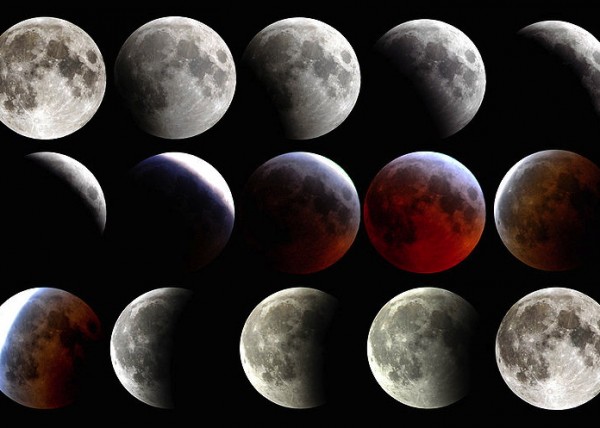There are several lunar and solar eclipses in the course of every year. Which are more common? That depends on what types of lunar eclipses you decide to include in the final tally.
Let’s define terms. A total solar eclipse happens when the moon passes in front of the sun – like the one coming up on March 8-9, 2016 – blotting it from view.
During a total lunar eclipse the moon totally passes through Earth’s dark umbral shadow and often exhibits a coppery red color. The image at top shows a total lunar eclipse.

But there’s more than one type of solar eclipse, and lunar eclipse. There are the partial phases of each, of course. And there’s also a penumbral lunar eclipse, like the one shown at right. The left-side image shows a moon in penumbral eclipse. The right-side image shows a full moon with no eclipse. See the difference?
A penumbral lunar eclipse is a very subtle kind of eclipse. Here’s how it happens. There are two parts to Earth’s shadow: a dark inner umbra and a lighter outer penumbra. And so there are two kinds of lunar eclipse: umbral and penumbral. A penumbral eclipse happens when Earth’s lighter outer shadow brushes the moon’s face. Some people say they can’t perceive a penumbral eclipse even as it’s happening. From the moon, the eclipse would be much more obvious, for you would see the Earth partially eclipsing or blocking out the sun. In fact, when you’re watching a partial solar eclipse from Earth, you’re standing in the moon’s penumbral shadow.
So which is more common, a solar eclipse or a lunar eclipse? It’s sometimes said that on a worldwide scale solar eclipses outnumber lunar eclipses by about a three to two margin. But that figure completely ignores penumbral lunar eclipses. When you include penumbral lunar eclipses, the number of solar and lunar eclipses is almost the same.
In fact, once you include penumbral eclipses, lunar eclipses slightly outnumber solar eclipses. In his classic book More Mathematical Astronomical Morsels, the famous Belgium astronomer Jean Meeus reported that there were 228 solar eclipses and 229 lunar eclipses in the 20th century, from the years 1901 to 2000. For the years 1 to 3000, Jean Meeus figures there are 7,124 solar eclipses and 7,245 lunar eclipses.
And for the 5,000-year period from 2000 B.C. to A.D. 3000, NASA’s Fred Espenak – sometimes known as Mr. Eclipse – finds 11,847 solar and 12,186 lunar eclipses.
By the way, all solar eclipses happen at new moon, when the moon passes more or less between the Earth and sun. During a total solar eclipse, a rim of twilight encircles your entire horizon, the sky turns dark and stars pop into view. Meanwhile, in the sky, the sun’s fiery corona can be seen surrounding the dark orb – the moon – that is completely covering the sun.
Why not an eclipse at every full and new moon?
All lunar eclipses happen at full moon, when Earth’s dark shadow totally or partially covers the moon. They are less dramatic than solar eclipses, but no less wonderful. You see Earth’s shadow on the moon’s face as a dark ‘bite’ taken out of the moon. This darkness creeps across the moon’s face during the several hours of the eclipse.
Both solar eclipses and lunar eclipses are beautiful, in their own way!

Bottom line: It’s sometimes said that, on a worldwide scale, solar eclipses outnumber lunar eclipses by about a three to two margin. But that doesn’t count penumbral eclipses. When you include penumbral lunar eclipses, the number of solar and lunar eclipses is almost the same, with lunar eclipses slightly outnumbering solar eclipses.











